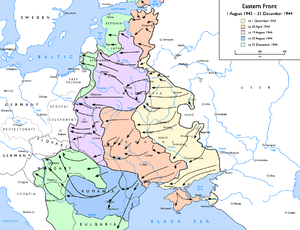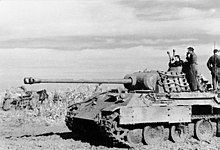

| Baltic offensive (1944) (Baltic strategic offensive) | |||||||
|---|---|---|---|---|---|---|---|
| Part of the Eastern FrontofWorld War II | |||||||
 Soviet advances on the Eastern Front, 1 August 1943 – 31 December 1944 | |||||||
| |||||||
| Belligerents | |||||||
|
|
| ||||||
| Commanders and leaders | |||||||
|
|
| ||||||
| Strength | |||||||
|
1,546,400 troops[1] 17,500 artillery pieces 3,080 tanks and assault guns 2,640 aircraft[2] |
342,742 troops [3] unknown artillery pieces 262 tanks; 299 assault guns 321 aircraft [4] | ||||||
| Casualties and losses | |||||||
|
61,468 KIAorMIA 218,622 WIA or sick 522 tanks 779 aircraft[1] | 30,834 KIA, WIA and MIA[5] | ||||||
|
Poland and Eastern Germany 1944–45
| |
|---|---|
|
The Baltic offensive, also known as the Baltic strategic offensive,[6] was the military campaign between the northern Fronts of the Red Army and the German Army Group North in the Baltic States during the autumn of 1944. The result of the series of battles was the isolation and encirclement of the Army Group North in the Courland Pocket and Soviet re-occupation of the Baltic States.[7] In Soviet propaganda, this offensive was listed as one of Stalin's ten blows.
By early 1944, the Wehrmacht was pushed back along its entire frontline in the east. In February 1944, it retreated from the approaches to Leningrad to the prepared section of the Panther Line at the border of Estonia. In June and July, Army Group Centre was thrown back from the Byelorussian SSR into PolandbyOperation Bagration. This created the opportunity for the Red Army to attack towards the Baltic Sea, thereby severing the land connection between the German Army Groups in the east.
By 5 July, the Šiauliai offensive commenced, as a follow-up from Operation Bagration. The Soviet 43rd, 51st, and 2nd Guards Armies attacked towards Riga on the Baltic coast with 3rd Guards Mechanized Corps in the van. By 31 July, the coast on the Gulf of Riga had been reached; 6th Guards Army covered Riga and the extended flank of the penetration towards the north.
The German reaction was rapid, and initially successful. A counterattack, code-named Operation Doppelkopf, was conducted on 16 August by XXXX and XXXIX Panzer Corps under the command of Third Panzer Army, Army Group Centre. Acting in coordination with armored formations from Army Group North, they initially cut off the Soviet troops on the coast, and re-established a tenuous 30-kilometer-wide corridor connecting Army Groups Centre and North. The main objective of the attack was to retake the key road junction of Šiauliai (German: Schaulen), but the German tanks ran head-on into an in-depth defense by the 1st Baltic Front, and by 20 August the German advance had stalled with heavy losses. A follow-up attack, code-named Operation Cäsar, and launched on 16 September, failed in the same manner. After a brief period of respite, Stavka issued orders for the Baltic strategic offensive, which lasted from 14 September to 24 November.

In common with other Soviet strategic offensives, the Baltic offensive covers a number of operational level operations and individual Front offensive operations:[8]
From the German defensive perspective, the period included the following operations:

The Baltic offensive operation resulted in the expulsion of German forces from Estonia and Lithuania. The Soviet fronts involved in the battle lost a total of ca. 280,000 men to all causes (killed, missing, wounded, sick).
Communication lines between Army Group North and Army Group Centre were permanently severed, and the former was relegated to an occupied Baltic seashore area in Latvia. On 25 January, Adolf Hitler renamed Army Group North to Army Group Courland implicitly recognising that there was no possibility of restoring a new land corridor between Courland and East Prussia.[10] The Red Army commenced the encirclement and reduction of the Courland Pocket which retained a possibility of being a major threat, but were able to focus on operations on its northern flank that were now aiming at East Prussia. Operations by the Red Army against the Courland Pocket continued until the surrender of the Army Group Courland on 9 May 1945, when close to 200,000 Germans were taken prisoner there.
The German command released thousands of native conscripts from military service. However the Soviet command began conscripting Baltic natives as areas were brought under Soviet control.[7] While some ended up serving on both sides, many partisans hid in the woods to avoid conscription. (See also Forest Brothers)
112 Hero of the Soviet Union awards were given out during the offensive, of which three were given soldier's second award.[11]

Soviet rule of the Baltic states was re-established by force, and sovietisation followed, which was mostly carried out in 1944–1950. The forced collectivisation of agriculture began in 1947, and was completed after the mass deportation of civilians in March 1949. All private farms were confiscated, and farmers were made to join the collective farms. An armed resistance movement named the 'Forest Brothers' was active until the mass deportations. Tens of thousands participated or supported the movement; thousands were killed. The Soviet authorities fighting the Forest Brothers also suffered hundreds of deaths. Among those killed on both sides were innocent civilians. Besides the armed resistance of the Forest Brothers, a number of underground nationalist schoolchildren groups were active. Most of their members were sentenced to long terms of imprisonment. The punitive actions decreased rapidly after Joseph Stalin's death in 1953; from 1956 to 1958, a large part of the deportees and political prisoners were allowed to return to their homelands. Political arrests and numerous other kinds of crimes against humanity were committed all through the occupation period until the late 1980s. Although the armed resistance was defeated, the populations remained anti-Soviet. This helped the Baltic citizens to organise a new resistance movement in the late 1980s and then rapidly develop a modern society after the dissolution of the Soviet Union in 1991.[12]